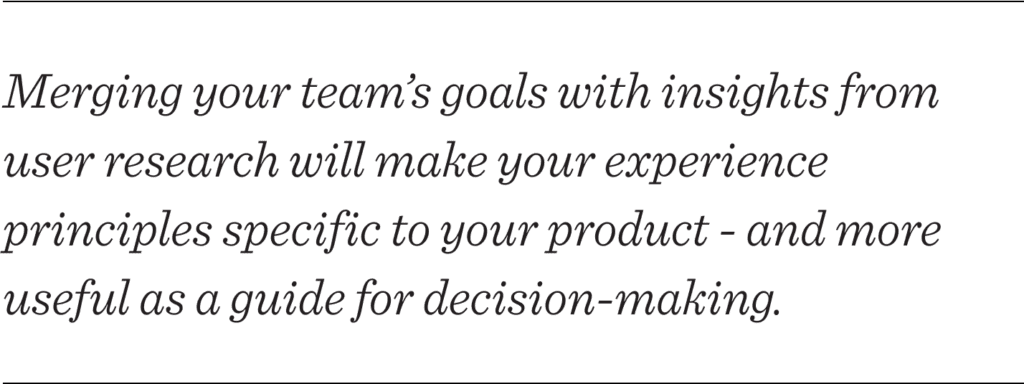Design thinking in the Age of AI
AI is transforming how we live, work, and communicate. With AI’s help, we can move from idea to product launch at super-speed. Never before have we been able to move
▪ September 26, 2025▪ February 7, 2023
Are you using experience principles? Maybe a better question is: are you using your principles to their full potential? Unfortunately, for most product teams, aside from the occasional vague reference to them during a brainstorm, experience principles get buried and forgotten.
Ideally, experience principles create clarity, value, and consistency across your product or service. If they’re overlooked or underused when put into practice, it can complicate decision-making, slow the design process, and ultimately detract from the overall user experience.
Here’s what you need to know to ensure you have a robust set of principles that aren’t just collecting dust in your digital product strategy.

Experience principles are directional phrases that help align the product experience with your user’s needs, expectations and values. Often, when a product team designs a new feature or new-to-market product, business needs drown out the customer’s perspective. The goal of experience principles is to incorporate the user’s priorities in tandem with the business’s.
Centering the user’s voice is critical. You can do this many ways, including analyzing existing data or qualitative research, personas, an empathy exercise, or a combination thereof. If you do not have a strong foundation of customer research, you can still craft principles to surface the team’s understanding of goals for the user. They will help create consistency in the user experience and can be refined over time as you gain more knowledge about your users.
By using the information you have to bring the user “in the room” to create experience principles, you help neutralize opinions and spur conversations about priorities and trade-offs when defining the product. This collaborative effort ensures a shared understanding and buy-in that will set your team up for success.
It’s hard to know where to begin when designing a new feature or a new-to-market product. Humans are natural problem-solvers, so it makes sense that we tend to throw a bunch of design solutions at the wall to see what sticks.

Taking the time to create experience principles can do wonders for focusing those ideation sessions by helping define your product, clarify its value, and re-center the customer in the experience. An exercise to suss out your experience principles empowers your team to prioritize their designs and gives everyone concrete criteria to evaluate and test the user experience against.
Experience principles help you achieve various goals:
To get the most value from your experience principles, you need to know how to create compelling principles and what you can do to make them stick.
Practically speaking, how do you generate experience principles that serve as precepts for any experience, no matter how a product evolves? It starts in a workshop.
Before you roll your eyes: we know that conducting a productive workshop can be tricky when there is a lot of thinking and synthesis required and not a lot of time to do it. That’s why we recommend an iterative “apart-together” approach to maximize everyone’s brains and bandwidth.
Step 1 (Apart): Gather Inputs, Including Your Team’s Initial Thinking
First, share with your team any customer research, feedback from customer support, personas, or other sources that summarize customer insights. Before the workshop, send a short survey to get your team’s thoughts bubbling around the intended product experience. Here are three questions we like to use that focus on the value to the user:

Step 2 (Together): Hold a Workshop to Review Themes and Generate Principles
Display your customer research and internal survey results for your team’s review. Discuss the themes from your survey and pinpoint where you have a consensus and where your ideas diverge. The themes you discover around shared values and attributes for the experience are a starting point for generating your principles.
In breakout groups, take one experience theme from your survey and a related user insight from your customer research. Then discuss:
For example, an experience theme from your pre-workshop survey is product customization. You know from past research that customers don’t fully understand the benefits and level of customization your product offers. Therefore, your experience principle could be: “Weave custom into the entire experience.” Combining an experience theme and research helps generate principles that are specific to your product and users, which will have a more significant impact on shaping the experience.

Each group then presents their principles to the whole team. At the end of the workshop, everyone votes for the principles that resonate, keeping in mind that the statements are in draft form.
Step 3 (Apart): Synthesize The Workshop Into a Set of Principles
After the workshop, spend heads-down time refining the language of your prioritized principles. The principles that tend to stick are:
Aim to generate 3-6 principles that would be comprehensible to anyone in your organization, no matter their department or position. The formula we like is a pithy statement with a one-sentence description underneath, plus 2 or 3 helpful examples that illustrate the principle without being prescriptive.
Tip: One trick to creating principles that stick is to make them action-oriented, so start your statements with verbs. For example, “Intuitive” can describe any digital product, but “Blend seamlessly with their daily routine” is a more precise phrase that fully captures the intended experience.
Step 4 (Apart & Together): Share With Your Team and Refine
Share your drafted principles with the group before meeting so everyone can digest the information. When you meet to discuss how the principles sit with the group, ask:
From there, you can refine the principles into a set of criteria that feels cohesive, consistent, and authentic.
You worked hard to create these principles, and they deserve a better fate than being doomed to a deck in a strategy doc graveyard. Instead, make an artifact that’s convenient to locate. You want your principles to be functional and relevant to your organization, so reduce the effort it takes for your team to cite them. Notion, Miro, and Figma are just some tools you can use to conveniently access your principles.
Wherever you are in product development, think about what you can do to incorporate the principles into your process right away. Putting the principles to work early shows their value and creates buy-in with broader stakeholders. Here are a few ideas of where they can contribute:
As you put them to use in different ways, your experience principles will ideally become embedded into your organization’s process and thinking. You may even hear them unwittingly cited by your team – the ultimate sign you’ve created principles that stick.

Creating experience principles that feel authentic to your user and your business isn’t always easy. An outside perspective can help.
At Everyday Industries, we facilitate workshops and synthesize frameworks that are the foundation to successful design outcomes. Learn how our product design services can help get your team aligned in order to create strategic, user-focused products.
AI is transforming how we live, work, and communicate. With AI’s help, we can move from idea to product launch at super-speed. Never before have we been able to move
▪ September 26, 2025Customer journey maps for wellness tech products are powerful tools to strengthen the digital experience and increase adoption. No matter where you are in developing your product, you can use strategies to uncover and shape the customer journey to ensure the most important elements of the experience are accounted for and thoughtfully defined.
▪ February 16, 2024If your goal is a user-centered product, analysis of your user research is an important step in defining the details that will align your product with users’ needs. Learn a process for data analysis that will make decision-making and design more effective.
▪ December 7, 2023